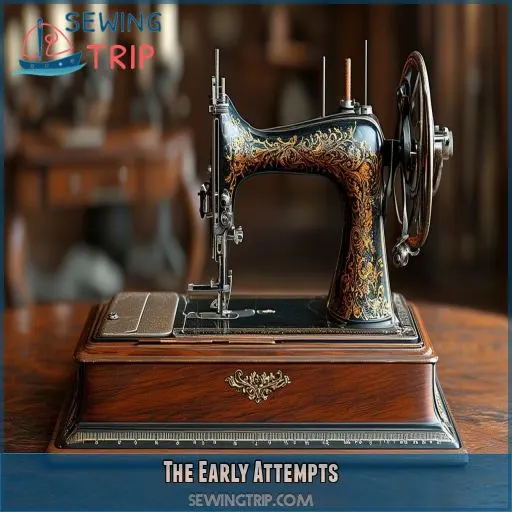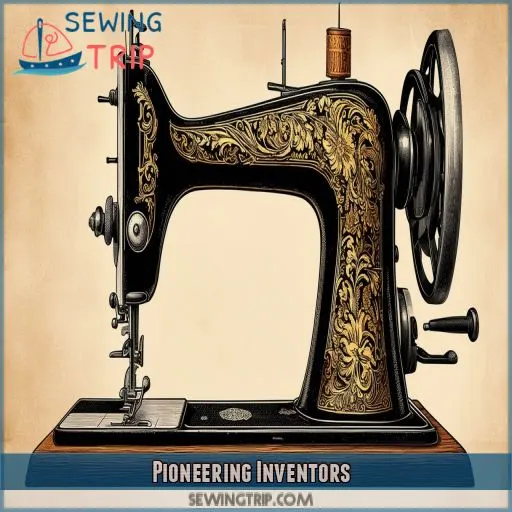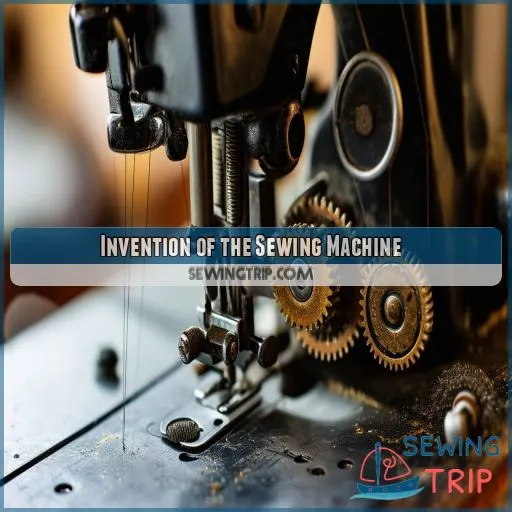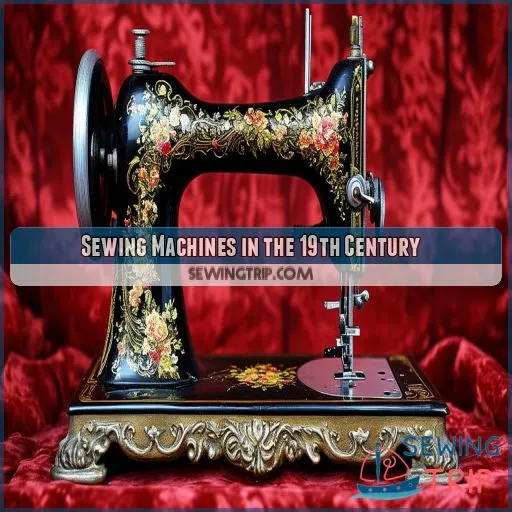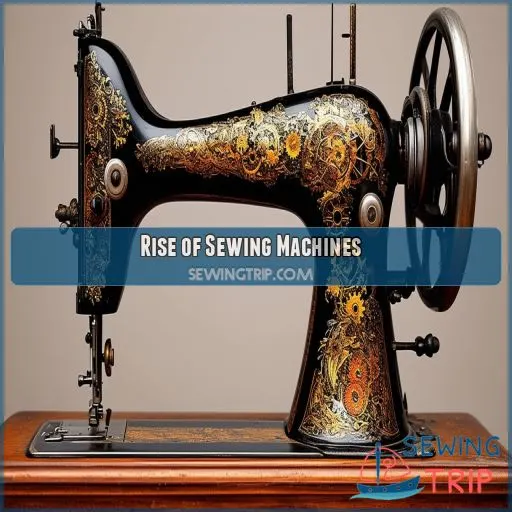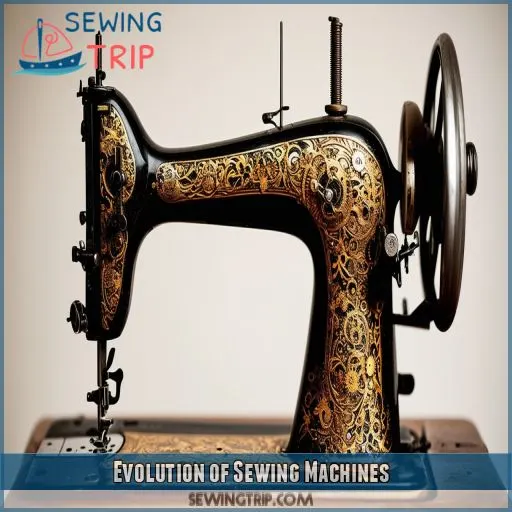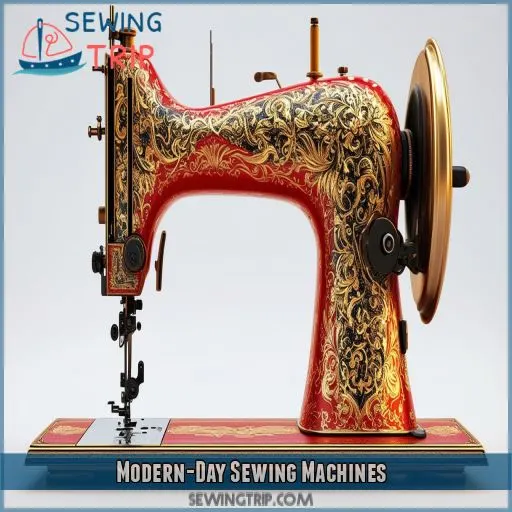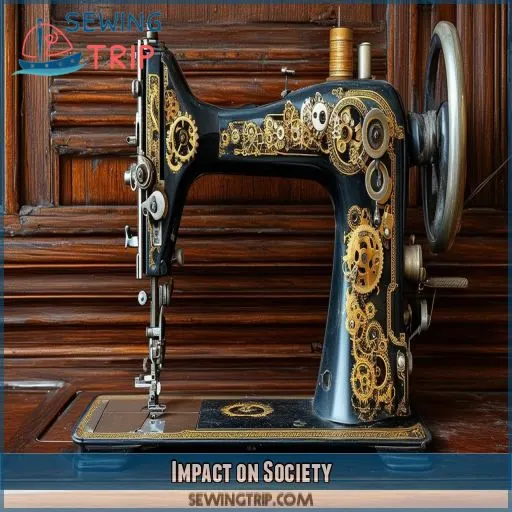This site is supported by our readers. We may earn a commission, at no cost to you, if you purchase through links.
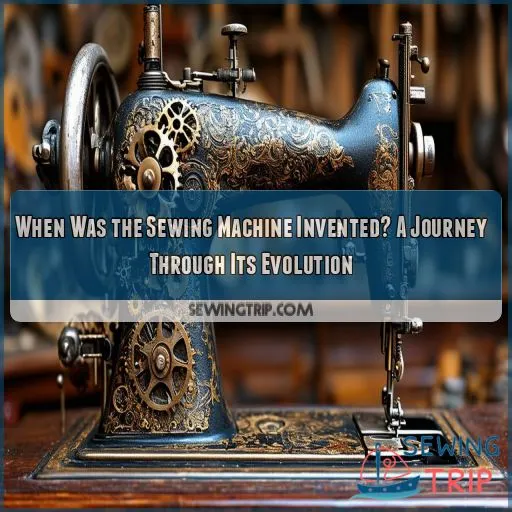 The sewing machine is one of the most transformational inventions in textile manufacturing, and it has a very rich history dating back to the beginning of the early Industrial Revolution.
The sewing machine is one of the most transformational inventions in textile manufacturing, and it has a very rich history dating back to the beginning of the early Industrial Revolution.
Early attempts were made by Balthasar Krems and Josef Madersperger in the very early 1800s.
Getting into its evolution, you would trace contributions from pioneers like Isaac Singer to how modern-day machines finally came.
Find out when the sewing machine was invented and how it helped revolutionize society.
Table Of Contents
Key Takeaways
- The sewing machine, a stitch in time that saved nine, was invented by Elias Howe in 1846.
- From the palaces of Vienna to the factories of the Industrial Revolution, the sewing machine has left an indelible mark on society.
- Isaac Singer’s marketing savvy and business acumen gave the sewing machine the push it needed to become a household name.
- The sewing machine, once a tool for the elite, has become a democratizing force in fashion, making stylish clothing accessible to all.
When Was the Sewing Machine Invented?
The sewing machine, a revolutionary tool in textile manufacturing, was invented over a series of developments in the early 19th century. Early designs, like Balthasar Krems’ 1810 model and Josef Madersperger’s 1815 machine, laid the groundwork.
The pivotal moment came in 1830 when Barthélemy Thimonnier introduced his chain stitch machine. However, the true game-changer was Elias Howe’s 1846 patent featuring an eye-pointed needle and shuttle system, establishing a foundation for modern machines.
Curious about how these inventions shaped the textile industry? Let’s unravel more of this fascinating evolution together.
The Early Attempts
The sewing machine’s early attempts trace back to Balthasar Krems’ automatic sewing machine in 1810, followed by Josef Madersperger’s efforts in 1815. In 1818, John Knowles and Reverend John Adams Dodge created an early example, though none fully succeeded in transforming the textile industry.
Balthasar Krems, 1810
In 1810, Balthasar Krems, an Austrian tailor, patented one of the earliest known sewing machine designs. Krems’s contributions laid the groundwork for the sewing machine’s evolution, showcasing Austria’s role in the industry’s nascent stages. His invention impacted Vienna’s sewing landscape, foreshadowing the social implications of this transformative technology.
Josef Madersperger, 1815
Again, one of the early sewing machine inventors is Josef Madersperger. His improved machine was patented in 1815. Although it worked only on straight lines, Madersperger’s machine made a tremendous development in sewing technology.
He remained poor and never commercialized his invention. This patent is considered a deduction toward practical sewing machines that have become so familiar to us today but whose legacy has never really been credited for it.
John Knowles and Reverend John Adams Dodge, 1818
In 1818, John Knowles and Reverend John Adams Dodge partnered to create an early sewing machine design. Their invention, though not as successful as later models, demonstrated the growing interest in automating the tedious task of stitching fabric. This pre-Howe sewing machine foreshadowed the impact these machines would have on the textile industry in the decades to come.
Pioneering Inventors
Barthélemy Thimonnier in 1830 and Walter Hunt in 1834 pioneered early designs which laid the groundwork for modern sewing machines. Thimonnier’s chain-stitch mechanism and Hunt’s straight-stitch design were essential steps toward the efficient models we use today.
Barthélemy Thimonnier, 1830
In 1830, Barthélemy Thimonnier created a chain stitch sewing machine, pivotal during the Industrial Revolution. However, his innovation led to social unrest; rioting tailors feared unemployment and destroyed his machines. Despite its potential, Thimonnier, a poor inventor, died in poverty, never benefiting from his groundbreaking work that would later propel sewing machine brands to prominence.
Walter Hunt, 1834
Walter Hunt, an American inventor, designed a sewing machine in 1834 that could create a "lock stitch" – a significant advancement over previous attempts. His machine featured two needles and could stitch straight seams, making it a labor-saving device that foreshadowed the sewing machine’s impact on mass production and women’s work in the home economics movement.
- Pioneering Sewing Machine Design
- Innovative "Lock Stitch" Feature
- Labor-Saving Impact on Production
- Influence on Women’s Domestic Work
Invention of the Sewing Machine
After the innovating pioneers, now comes the crucial part—Elias Howe’s 1846 patent. Howe had still another innovative design with an eye-pointed needle and shuttle system, which made a lockstitch in sewing possible. This paved the way for a sea change in garment manufacturing.
| Key Feature | Description |
|---|---|
| Eye-Pointed Needle | A needle with the eye located near the point. |
Although Howe’s machine didn’t quite get off the ground in the first instance, it really laid the industrial sewing revolution foundation. His vision propelled Sewing technology forward, lumbering designs evolving into efficient, modern machines.
Sewing Machines in the 19th Century
The sewing machine seemed to have an almost overwhelming effect on society during the 19th century. As factories grew, so did urbanization, and women flooded into the working field in droves. This change to workers wasn’t without its problems—health and safety issues within factories became paramount.
Despite all the obstacles, the sewing machine refashioned domestic life. Parents could afford to buy their own sewing machines for home use; the skills of home economics were built, and creativity was allowed. Indeed, the age was also typified by furious patent battles, notably between Elias Howe and Isaac Singer. Such lawsuits often tarnished the contributions made by these inventors but underlined another point: that innovation is very competitive. Long story short, the sewing machine did alter both industrial operations and household management in the 19th century.
Rise of Sewing Machines
Isaac Singer’s improvements to the sewing machine, such as the eye-pointed needle and foot pedal, helped drive its widespread adoption. The formation of the Sewing Machine Combination, a patent pool among seven manufacturers, further solidified the sewing machine’s rise and dominance in the 19th century.
Contributions of Isaac Singer
Isaac Singer revolutionized sewing machines by introducing significant innovations and aggressive marketing. His improvements made the machines more efficient, while his business acumen propelled their popularity.
- Leveraged the eye-pointed needle design
- Added a foot pedal for hands-free operation
- Built a robust marketing strategy
- Established a thriving business model
- Created affordable, user-friendly machines
Singer’s impact on the sewing machine industry was monumental.
Formation of the Sewing Machine Combination
Building on Singer’s success, the major manufacturers formed the Sewing Machine Combination in 1856. This patent pool aimed to reduce litigation and foster innovation. However, contrary to expectations, it stifled competition and innovation, particularly among its members. Business tactics focused more on legal battles than technological advancements, marking a complex chapter in sewing machine history (Source).
Evolution of Sewing Machines
The first electric home sewing machines emerged in the early 20th century, offering greater convenience and power compared to manual models. Throughout the late 1900s, sewing machines continued to evolve with advanced features like computerized controls, specialized stitches, and enhanced ease of use.
The First Electric Home Sewing Machines
By the early 20th century, the first electric home sewing machines emerged, revolutionizing domestic sewing. These machines, powered by electricity, offered significant advantages like consistent stitching speed and reduced physical effort. Safety concerns were addressed with improved designs. Portable models made sewing more convenient, and affordable options widened access. Maintenance techniques evolved, ensuring longevity and reliability.
Advances in Sewing Machines Through the Late 1900s
Advances in sewing machines through the late 1900s saw the emergence of computerized sewing machines, which added precision and ease of use. Electric sewing machines became even more sophisticated with features like automatic threading. Embroidery machines gained popularity for intricate designs, while sergers provided professional seam finishes. Specialty machines catered to specific materials like leather and denim, enhancing versatility.
Modern-Day Sewing Machines
Modern-day sewing machines boast an array of innovative features, from computerized controls to specialized stitches for various fabrics. Leading brands like Singer, Janome, and Brother continue to push the boundaries of sewing technology, offering home sewers and professionals alike a wealth of advanced capabilities.
Unique Features of Modern-Day Sewing Machines
Modern-day sewing machines boast advanced features such as:
- Computerized sewing, automating complex patterns.
- Embroidery machines for intricate, decorative stitching.
- Sergers, efficiently finishing seams.
- Specialized machines for specific materials, like leather or denim.
- User-friendly interfaces with digital screens.
These innovations simplify sewing, enhancing both precision and creativity in your projects.
Popular Sewing Machine Brands
Brands like Brother, Singer, and Janome dominate the sewing machine market. Their innovative products, strong marketing strategies, and solid brand reputations drive customer loyalty. Bernina also remains a key player known for premium quality. Each brand continues to push boundaries, ensuring they maintain market dominance through constant improvement and meeting customer demands efficiently.
Impact on Society
The sewing machine‘s impact on society was profound. It transformed the nature of work, leading to the growth of urban and industrialized workforces. Suddenly, clothing production could be mechanized, reducing labor costs and boosting efficiency. This shift impacted gender roles, as more women entered the workforce as seamstresses and factory workers.
The sewing machine also blurred class distinctions, making fashionable clothing more accessible to the masses. No longer were the wealthy the only ones who could afford stylish attire. This democratization of fashion empowered individuals to express their personal style. The sewing machine’s legacy continues today, with its influence still felt in the textile and garment industries, as well as in the creative pursuits of home sewers.
Frequently Asked Questions (FAQs)
When was the first sewing machine invented?
The first practical sewing machine was invented by Elias Howe in Howe’s design featured an eye-pointed needle and shuttle to create the lockstitch, revolutionizing the textile industry and enabling mass clothing production.
How much was a sewing machine in the 1800s?
You’d be sewing up a storm if you could afford one of those newfangled machines back in the 1800s! Prices ranged from a whopping $100 to a staggering $300 – enough to make even the wealthiest blush. But hey, at least you’d be the talk of the town!
Was the sewing machine invented in 1846?
Yes, the sewing machine you’re referring to was patented by Elias Howe in Although earlier versions existed, Howe’s design, featuring an eye-pointed needle and shuttle to create a lockstitch, was the first successful one.
Were there sewing machines in 1910?
By 1910, electric sewing machines had become widely available, making home sewing more efficient. These advanced models featured motors, allowing users to sew faster and with greater control over stitch length and tension.
How do sewing machines create different stitches?
Ironically, sewing machines blend simplicity and complexity to create different stitches. By adjusting tension, stitch length, and using various needle positions, you’ll swiftly switch from basic straight stitches to intricate patterns like zigzags and buttonholes.
What materials can modern sewing machines handle?
Modern sewing machines handle a wide range of materials, including cotton, wool, silk, denim, leather, and synthetic fabrics. Advanced models can adjust tension and stitch length automatically, ensuring professional results on diverse textiles.
What role did women play in sewing machine history?
Ah, the unsung heroines of sewing machine history! Women were the driving force behind its widespread adoption, leveraging the machine’s efficiency to transform domestic life and the textile industry. Their ingenuity paved the way for modern sewing.
How have sewing machines influenced fashion trends?
Sewing machines have drastically influenced fashion trends by enabling rapid, precise garment production, spurring innovation in design, and allowing for mass customization, which democratized fashion and made stylish clothing more accessible to diverse populations.
What are key features of computerized sewing machines?
Don’t think they’re complicated; computerized sewing machines are user-friendly with automatic needle threading, stitch selection, speed control, and programmable patterns. These features enhance precision, save time, and elevate your sewing projects to a professional level.
Conclusion
The sewing machine has covered seamless strides in stitching the fabric of society. It transformed textile production and revolutionized the way people dress themselves. From its humble beginnings to modern marvels, this ingenious invention wove its way into our daily life, thus making the art of sewing within reach like never before.
Consider the sewing machine’s vast history, and it will dawn on you how such a fine innovation has formed the world that’s today and goes on to be essential in our tapestry of life.

